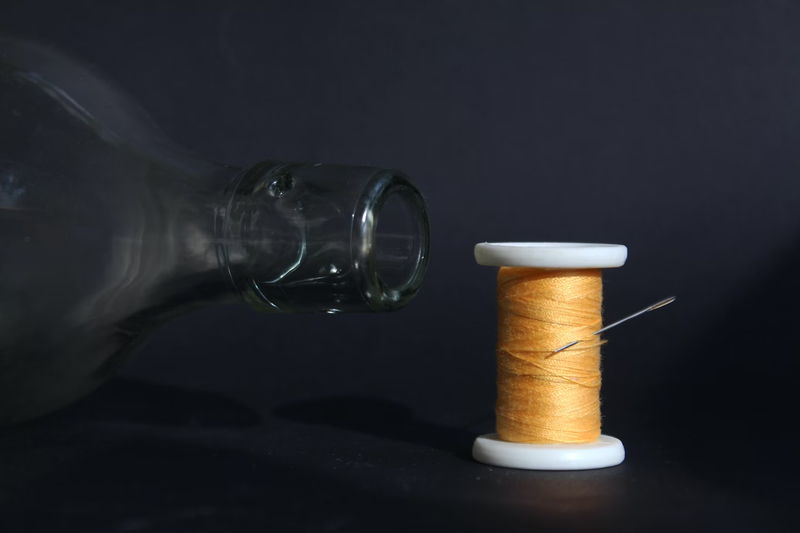Before I put my dress coat away for the season, I sew on a button. When it fell off weeks
ago, I stuck it in my coat pocket, intending to fix it soon. But mending is such a dull chore. So, I
didn’t, until now.
I select a dual duty, black, polyester thread from the sewing basket. Even with glasses, I
squint when I thread the needle. I even up the ends of the thread and double knot them. Then, I
align the button with the buttonhole. This isn’t a flat, four-holed button that requires careful, neat
stitches, but a shank button with a plastic loop on the bottom. My stitches will be hidden from
view.
I, a woman who’d rather staple than stitch a fallen hem, have three sewing boxes. The
one I use the most, a fancy, blue basket with an embroidered top was my mother’s. The pink one
styled like a tacklebox was my granny’s. Long before I inherited either of these, I made a kit
from a Child Life shoebox that once held a pair of expensive, white, 5 EE, ¾ leather boots that
my mother insisted on buying my son. When he was a child, my son used the supplies in that
shoebox to turn old clothes and curtains into costumes for his imaginative play or to sew badges
onto his Boy Scout or Civil Air Patrol uniforms. One of my few sewing projects was a “General
Grant shirt” that I made when he was seven and fascinated with the “Silver War,” as he called it.
I removed the buttons and insignia from a Cub Scout shirt I bought at Goodwill and decorated it
with a double row of brass buttons and gold stars and rank bars appliques. He wore this shirt
until he could no longer button it.
My needle slips through the loop on the shank, dips into the cloth, and reappears. I imagine a belted kingfisher, one of my favorite birds, plunging headfirst into the water, wings
folded against the sides of its body, and then rising with a flopping fish, one of many it’ll catch
that day, in its needlelike bill: the kingfisher stitching the creek.
My mother was thrilled when the midwife asked her to cut her grandson’s umbilical cord.
When my daughter was born, her father severed the arteries and veins in the rubbery gray tube
that linked her and me. If I were to redo my children’s births, I’d allow the cord to remain
attached to the placenta, continuing to nourish them until the cord dried and separated on its own,
leaving a healed umbilicus. A “lotus birth,” it’s called. Don’t severe a tie if you don’t have to, I
say.
If a shank button isn’t firmly attached, it feels wobbly and likely to fall off, so I loop over
and under more times than I need to. The stitches on the underside of the cloth are a messy bird’s
nest.
My son and I talk by phone almost every day. If he’s sober, he says little about his life
and expresses no curiosity about mine, a taciturnity that has increased with time. Apparently,
even minor revelations – his or mine – feel dangerous to him when he’s clear-headed. But when
he’s drinking, he can be garrulous, testy, funny, and self-disclosing. The best time to call if I
wanted colorful, long-winded answers to my questions was on a Friday evening when he was
unwinding after the work week. On such evenings, he might let it slip that drinking was making
a mess of his life and that he’d never be able to quit (“Fuck hope!” he once said). I wanted to ask
why the fabric of his life had so unraveled and how he might mend it, but if I had, even on such a
Friday evening, without a word, he’d have ended the call, not with the definitive slam of a rotary
receiver followed by the hum of a dial tone, but with the silent cutting of the invisible cellphone
line that would have left me wondering for a moment if he was there or gone.
After I’ve attached the button, I strengthen the stitches that hold it by wrapping the thread
around them six times. Then, I wrap it two more times for good measure.
I miss a coiled telephone cord, a visible reminder of the connection between two
speakers. But somewhere, cords and cables connect my son and me, even though I can’t see
them and don’t know how they work.
He says little about probation and nothing about the required abstinence – if that’s even
what he’s doing. But actually, I think that he is abstaining, because now, there’s more silence
than talk between us, even on Friday nights, silences I refuse to fill with chatter. When he does
speak, it’s about the weather or where he’s going to fish that weekend. I miss his loose talk and
yet, this persistent taciturnity feeds my hope. During the long silences, I picture him casting out a
line bearing one of the colorful jigs he’s tied with deer hair, waiting for it to catch, and then,
reeling it in with a flopping fish, one of many he’ll catch that day: my son stitching the lake.
Though I wonder the point of our mostly silent telephone calls, I don’t ask. My son
wouldn’t call if he wasn’t getting something from them. So, we sit in silence. “Talk tomorrow?”
he finally says. “I’m here,” I always reply. He signs off by telling me that he loves me, and I tell
him the same. How thin, how tenuous this thread seems. And yet, it’s a dual duty, polyester
thread, wound eight times, and knotted twice. It will hold. I clip it close to the knot.
____________________________________________________________________________________________________________________________
Lisa Knopp
____________________________________________________________________________________________________________________________
____________________________________________________________________________________________________________________________
CREATIVE NONFICTION
Lisa Knopp is the author of seven books of creative nonfiction. Her most recent is a memoir/biography, From Your Friend, Carey Dean: Letters from Nebraska’s Death Row (2022). Her essays have appeared in many of the best publications, including Shenandoah, Gettysburg Review, Michigan Quarterly Review, Missouri Review, Connecticut Review, Creative Nonfiction, Iowa Review, Prairie Schooner, Northwest Review, Georgia Review, Brevity, and Seneca Review. Seven of her essays have received notable essay citations in the Best American Essays series. Since 2005, Lisa has been a professor of English at the University of Nebraska-Omaha where she teaches courses in creative nonfiction. She lives in Lincoln, Nebraska. www.lisaknopp.com is a poet, mother and grandmother currently living in Asheville, NC. She is the author of several chapbooks including The Water Cycle (Variant Literature) and How to Keep Things Alive (Split Rock Press, forthcoming October 2023). Her poems have been published in Poet Lore, Citron Review, SWWIM, Pithead Chapel, Moist Poetry, Okay Donkey and others. Beth is Managing Editor of Feral: A Journal of Poetry and Art, Assistant Editor of Animal Heart Press, and Grandma of Femme Salve Books. Twitter Instagram, and BlueSky @bethgordonpoet. and elsewhere. Connect on Twitter at @Lukesrant or through email: [email protected]..
_________________________________________________________________________________________________________________________________________________________________________
__________________________________________________________________________________________________________________________________________________________________________
Stay Connected to Our Literary Community. Subscribe to Our Newsletter
©2023 West Trade Review
Image by Maria Ionova from Unsplash



